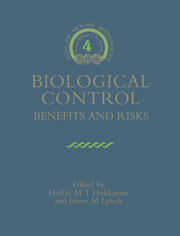Book contents
- Frontmatter
- Contents
- List of Contributors
- Series Preface
- Preface: Overview of Benefits and Risks of Biological Control Introductions
- Part I Biological Invasions
- Part II Classical Biocontrol
- Part III Augmentative Biocontrol
- Part IV Use of Genetically Modified Organisms
- 19 Assessing the Potential Benefits and Risks of Introducing Natural and Genetically Manipulated Bacteria for the Control of Soil-borne Root Diseases
- 20 Serodiagnostic Methods for Risk Assessment of Pseudomonas cepacia as a Biocontrol Agent
- 21 Benefits and Risks of Using Genetically Engineered Baculoviruses as Insecticides
- 22 Mathematical Modelling of Gene Exchange in Soil
- 23 Pest Resistance to Bacillus thuringiensis: Ecological Crop Assessment for Bt Gene Incorporation and Strategies of Management
- 24 An International Perspective for the Release of Genetically Engineered Organisms for Biological Control
- Part V Economics and Registration
- Index
21 - Benefits and Risks of Using Genetically Engineered Baculoviruses as Insecticides
Published online by Cambridge University Press: 07 May 2010
- Frontmatter
- Contents
- List of Contributors
- Series Preface
- Preface: Overview of Benefits and Risks of Biological Control Introductions
- Part I Biological Invasions
- Part II Classical Biocontrol
- Part III Augmentative Biocontrol
- Part IV Use of Genetically Modified Organisms
- 19 Assessing the Potential Benefits and Risks of Introducing Natural and Genetically Manipulated Bacteria for the Control of Soil-borne Root Diseases
- 20 Serodiagnostic Methods for Risk Assessment of Pseudomonas cepacia as a Biocontrol Agent
- 21 Benefits and Risks of Using Genetically Engineered Baculoviruses as Insecticides
- 22 Mathematical Modelling of Gene Exchange in Soil
- 23 Pest Resistance to Bacillus thuringiensis: Ecological Crop Assessment for Bt Gene Incorporation and Strategies of Management
- 24 An International Perspective for the Release of Genetically Engineered Organisms for Biological Control
- Part V Economics and Registration
- Index
Summary
Introduction
Insects are susceptible to a wide range of viral pathogens, but viruses of the family Baculoviridae, which occur only in arthropods, have received most attention because their high pathogenicity, narrow host range, and complete safety to vertebrates and plants, make them particularly promising candidates for biological pest control agents (see Huber, Chapter 18). Although natural strains of these viruses can in many cases provide highly satisfactory levels of control, the past 5 years has seen several attempts to produce genetically engineered baculoviruses with improved insecticidal properties. The chief target for these improvements has been reduction in the crop damage that continues to occur after infection of the insects.
A second reason for using genetically engineered baculovirus insecticides is to provide marked strains for ecological studies in a manner somewhat analogous to the way that animals are often marked physically in order to study in a more detailed way their behaviour and survival. Marked viruses may contain simply a short stretch of introduced DNA in their genome. This can be detected by various methods such as dot blotting, Southern blotting, restriction enzyme analysis (especially if the introduced DNA contains additional restriction sites), or, with much greater sensitivity, by use of the polymerase chain reaction. Alternatively, marked viruses may contain a reporter gene that expresses a protein, usually an enzyme, which can be detected easily and specifically. The E. colt lacZ gene, which codes for P-galactosidase, has been found particularly useful.
- Type
- Chapter
- Information
- Biological ControlBenefits and Risks, pp. 223 - 230Publisher: Cambridge University PressPrint publication year: 1995
- 1
- Cited by



